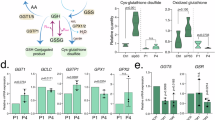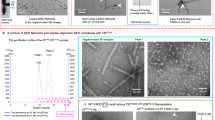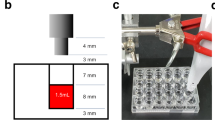Abstract
The transcription factor p63, member of the p53 family, is crucial for epithelial development. An RNAi screening identified the apoptotic gene Procaspase-8 as a target activated by p63. The caspase-8 inhibitor FLIP is also under p63 control. We analysed and detailed the direct transactivation through the use of RNAi, reporter assays, ChIPs, western blots, confocal studies in HaCat, as well as in primary human keratinocytes. The direct ΔNp63 regulation of these targets was confirmed in vivo using transgenic ΔNp63 mice under the K5 promoter, as compared with p63 knockout mice, and in vitro in normal human primary keratinocytes following UV irradiation. Lowering the steady state of p63 protein levels changes the relative ratio of FLIP isoforms, causing the activation of the expressed, inactive Procaspase-8, into the active isoform thus triggering the proapoptotic cascade. Therefore, p63 fine-tunes the Procaspase-8-FLIP pro- and antiapoptotic pathway in keratinocytes.
Similar content being viewed by others
Log in or create a free account to read this content
Gain free access to this article, as well as selected content from this journal and more on nature.com
or
Change history
10 December 2021
A Correction to this paper has been published: https://doi.org/10.1038/s41418-021-00896-8
Abbreviations
- TAp63:
-
amino-terminal transcriptional activation domain-containing p63
- ΔNp63:
-
transcriptional activation domain-deleted p63
- CHIP:
-
chromatin immunoprecipitation
- RNAi:
-
RNA interference
- DED:
-
death effector domain
- DISC:
-
death-inducing signalling complex
- FLIP:
-
flice inibitory protein
- NHEK:
-
normal human epidermal keratinocytes
- BCoR:
-
BCL-6 interacting corepressor gene
- K:
-
keratin
- tg:
-
transgenic mice
- KO:
-
knockout mice
References
McKeon F . p63 and the epithelial stem cell: more than status quo? Genes Dev 2004; 18: 465–469.
Aylon Y, Oren M . Living with p53, dying of p53. Cell 2007; 130: 597–600.
Mills AA, Zheng B, Wang XJ, Vogel H, Roop DR, Bradley A . p63 is a p53 homologue required for limb and epidermal morphogenesis. Nature 1999; 398: 708–713.
Yang A, Schweitzer R, Sun D, Kaghad M, Walker N, Bronson RT et al. p63 is essential for regenerative proliferation in limb, craniofacial and epithelial development. Nature 1999; 398: 714–718.
Rinne T, Hamel B, van Bokhoven H, Brunner HG . Pattern of p63 mutations and their phenotypes–update. Am J Med Genet A 2006; 140: 1396–1406.
Carroll DK, Carroll JS, Leong CO, Cheng F, Brown M, Mills AA et al. p63 regulates an adhesion programme and cell survival in epithelial cells. Nat Cell Biol 2006; 8: 551–561.
Senoo M, Pinto F, Crum CP, McKeon F . p63 Is essential for the proliferative potential of stem cells in stratified epithelia. Cell 2007; 129: 523–536.
Yang A, Kaghad M, Wang Y, Gillett E, Fleming MD, Dotsch V et al. p63, a p53 homolog at 3q27–29, encodes multiple products with transactivating, death-inducing, and dominant-negative activities. Mol Cell 1998; 2: 305–316.
Gressner O, Schilling T, Lorenz K, Schulze Schleithoff E, Koch A, Schulze-Bergkamen H et al. TAp63alpha induces apoptosis by activating signaling via death receptors and mitochondria. EMBO J 2005; 24: 2458–2471.
Lee H, Kimelman D . A dominant-negative form of p63 is required for epidermal proliferation in zebrafish. Dev Cell 2002; 2: 607–616.
Truong AB, Kretz M, Ridky TW, Kimmel R, Khavari PA . p63 regulates proliferation and differentiation of developmentally mature keratinocytes. Genes Dev 2006; 20: 3185–3197.
Yang A, Zhu Z, Kapranov P, McKeon F, Church GM, Gingeras TR et al. Relationships between p63 binding, DNA sequence, transcription activity, and biological function in human cells. Mol Cell 2006; 24: 593–602.
Viganò MA, Lamartine J, Testoni B, Merico D, Alotto D, Castagnoli C et al. New p63 targets in keratinocytes identified by a genome-wide approach. EMBO J 2006; 25: 5105–5116.
Testoni B, Borrelli S, Tenedini E, Alotto D, Castagnoli C, Piccolo S et al. Identification of new p63 targets in human keratinocytes. Cell Cycle 2006; 5: 2805–2811.
Lamkanfi M, Declercq W, Kalai M, Saelens X, Vandenabeele P . Alice in caspase land. A phylogenetic analysis of caspases from worm to man. Cell Death Differ 2002; 9: 358–361.
Shi Y . Caspase activation: revisiting the induced proximity model. Cell 2004; 117: 855–858.
Peter ME, Krammer PH . The CD95(APO-1/Fas) DISC and beyond. Cell Death Differ 2003; 10: 26–35.
Medema JP, Scaffidi C, Kischkel FC, Shevchenko A, Mann M, Krammer PH et al. FLICE is activated by association with the CD95 death-inducing signaling complex (DISC). EMBO J 1997; 16: 2794–2804.
Golks A, Brenner D, Fritsch C, Krammer PH, Lavrik IN . c-FLIPR, a new regulator of death receptor-induced apoptosis. J Biol Chem 2005; 280: 14507–14513.
Djerbi M, Darreh-Shori T, Zhivotovsky B, Grandien A . Characterization of the human FLICE-inhibitory protein locus and comparison of the anti-apoptotic activity of four different flip isoforms. Scand J Immunol 2001; 54: 180–189.
Ueffing N, Keil E, Freund C, Kuhne R, Schulze-Osthoff K, Schmitz I . Mutational analyses of c-FLIP(R), the only murine short FLIP isoform, reveal requirements for DISC recruitment. Cell Death Differ 2008; 15: 773–782. Jan 25.
Chang DW, Xing Z, Pan Y, Algeciras-Schimnich A, Barnhart BC, Yaish-Ohad S et al. c-FLIP(L) is a dual function regulator for caspase-8 activation and CD95-mediated apoptosis. EMBO J 2002; 21: 3704–3714.
Micheau O, Thome M, Schneider P, Holler N, Tschopp J, Nicholson DW et al. The long form of FLIP is an activator of caspase-8 at the Fas death-inducing signaling complex. J Biol Chem 2002; 277: 45162–45171.
Yeh WC, Itie A, Elia AJ, Ng M, Shu HB, Wakeham A et al. Requirement for Casper (c-FLIP) in regulation of death receptor-induced apoptosis and embryonic development. Immunity 2000; 12: 633–642.
Huynh KD, Fischle W, Verdin E, Bardwell VJ . BCoR, a novel corepressor involved in BCL-6 repression. Genes Dev 2000; 14: 1810–1823.
Candi E, Rufini A, Terrinoni A, Dinsdale D, Ranalli M, Paradisi A et al. Differential roles of p63 isoforms in epidermal development: selective genetic complementation in p63 null mice. Cell Death Differ 2006; 13: 1037–1047.
Liefer KM, Koster MI, Wang XJ, Yang A, McKeon F, Roop DR . Down-regulation of p63 is required for epidermal UV-B-induced apoptosis. Cancer Res 2000; 60: 4016–4020.
Ogawa E, Okuyama R, Ikawa S, Nagoshi H, Egawa T, Kurihara A et al. p51/p63 inhibits ultraviolet B-induced apoptosis via Akt activation. Oncogene 2008; 27: 848–856.
Isoherranen K, Westermarck J, Kahari VM, Jansen C, Punnonen K . Differential regulation of the AP-1 family members by UV irradiation in vitro and in vivo. Cell Signal 1998; 10: 191–195.
Takasawa R, Nakamura H, Mori T, Tanuma S . Differential apoptotic pathways in human keratinocyte HaCat cells exposed to UVB and UVC. Apoptosis 2005; 10: 1121–1130.
Sayan BS, Sayan AE, Yang AL, Aqeilan RI, Candi E, Cohen GM et al. Cleavage of the transactivation-inhibitory domain of p63 by caspases enhances apoptosis. Proc Natl Acad Sci USA 2007; 104: 10871–10876.
Liedtke C, Groger N, Manns MP, Trautwein C . The human caspase-8 promoter sustains basal activity through SP1 and ETS-like transcription factors and can be up-regulated by a p53-dependent mechanism. J Biol Chem 2003; 278: 27593–27604.
Krueger A, Schmitz I, Baumann S, Krammer PH, Kirchhoff S . Cellular FLICE-inhibitory protein splice variants inhibit different steps of caspase-8 activation at the CD95 death-inducing signaling complex. J Biol Chem 2001; 276: 20633–20640.
Li W, Zhang X, Olumi AF . MG-132 sensitizes TRAIL-resistant prostate cancer cells by activating c-Fos/c-Jun heterodimers and repressing c-FLIP(L). Cancer Res 2007; 67: 2247–2255.
Fukazawa T, Fujiwara T, Uno F, Teraishi F, Kadowaki Y, Itoshima T et al. Accelerated degradation of cellular FLIP protein through the ubiquitin-proteasome pathway in p53-mediated apoptosis of human cancer cells. Oncogene 2001; 20: 5225–5231.
Huang YP, Kim Y, Li Z, Fomenkov T, Fomenkov A, Ratovitski EA . AEC-associated p63 mutations lead to alternative splicing/protein stabilization of p63 and modulation of Notch signaling. Cell Cycle 2005; 4: 1440–1447.
Melino G, Knight RA, Cesareni G . Degradation of p63 by Itch. Cell Cycle 2006; 5: 1735–1739.
Kataoka T, Tschopp J . N-terminal fragment of c-FLIP(L) processed by caspase 8 specifically interacts with TRAF2 and induces activation of the NF-kappaB signaling pathway. Mol Cell Biol 2004; 24: 2627–2636.
Wachter T, Sprick M, Hausmann D, Kerstan A, McPherson K, Stassi G et al. cFLIPL inhibits tumor necrosis factor-related apoptosis-inducing ligand-mediated NF-kappaB activation at the death-inducing signaling complex in human keratinocytes. J Biol Chem 2004; 279: 52824–52834.
Koster MI, Dai D, Marinari B, Sano Y, Costanzo A, Karin M et al. p63 induces key target genes required for epidermal morphogenesis. Proc Natl Acad Sci USA 2007; 104: 3255–3260.
Denecker G, Hoste E, Gilbert B, Hochepied T, Ovaere P, Lippens S et al. Caspase-14 protects against epidermal UVB photodamage and water loss. Nat Cell Biol 2007; 9: 666–674.
Acknowledgements
We thank C Imbriano and M Romani for reagents, S Pozzi for help with human keratinocyte experiments. We thank S Rodeghiero and U Fascio at the CIMAINA facility for skilful assistance with confocal microscopy. MA Viganò was supported by UE-EPISTEM contract. This work was supported by Grants from Fondazione Cariplo to R.M. and UE-EPISTEM to R.M and G.M.
Author information
Authors and Affiliations
Corresponding author
Additional information
Edited by RA Knight
Supplementary Information accompanies the paper on Cell Death and Differentiation website (http://www.nature.com/cdd)
Rights and permissions
About this article
Cite this article
Borrelli, S., Candi, E., Alotto, D. et al. p63 regulates the caspase-8-FLIP apoptotic pathway in epidermis. Cell Death Differ 16, 253–263 (2009). https://doi.org/10.1038/cdd.2008.147
Received:
Revised:
Accepted:
Published:
Issue date:
DOI: https://doi.org/10.1038/cdd.2008.147
Keywords
This article is cited by
-
Beyond Death: Unmasking the Intricacies of Apoptosis Escape
Molecular Diagnosis & Therapy (2024)
-
Triptolide-mediated downregulation of FLIPS in hepatoma cells occurs at the post-transcriptional level independently of proteasome-mediated pathways
Medical Oncology (2022)
-
p63 is a prosurvival factor in the adult mammary gland during post-lactational involution, affecting PI-MECs and ErbB2 tumorigenesis
Cell Death & Differentiation (2014)
-
Bcl-3 regulates UVB-induced apoptosis
Human Cell (2013)
-
DeltaN TP63 reactivation, epithelial phenotype maintenance, and survival in lung squamous cell carcinoma
Tumor Biology (2012)



